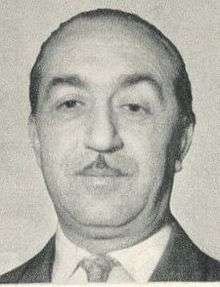Mongi Slim
| Mongi Slim | |
|---|---|
 | |
| 23rd President of the United Nations General Assembly | |
|
In office 1960–1961 | |
| Preceded by | Frederick Henry Boland |
| Succeeded by | Muhammad Zafrulla Khan |
| Minister of Foreign Affairs of Tunisia | |
|
In office 1962–1964 | |
| Preceded by | Sadok Mokadem |
| Succeeded by | Habib Bourguiba, Jr. |
| Personal details | |
| Born |
September 1, 1908 Tunis, Tunisia |
| Died |
October 23, 1969 (aged 61) Tunis, Tunisia |
| Political party | Neo Destour |
Mongi Slim (Tunisian Arabic: منجي سليم) (September 1, 1908 – October 23, 1969)[1] was a Tunisian diplomat who became the first African to become the President of the United Nations General Assembly in 1961. He received a degree from the faculty of law of the University of Paris. He was twice imprisoned by the French during the Tunisian struggle for independence.[2]
Early years
Born on September 15, 1908, in Tunis, Slim came from an aristocratic family of Greek and Turkish origin.[3] His mother was a member of the Beyrum family, a noble Turkish family which had risen to prominence in Tunis, and was famous throughout the Arab world for its learnedness in Moslem law. One of Slim's great-grandfathers, a Greek named Kafkalas, was captured as a boy by pirates, and sold as a mameluke (white slave) to the Bey of Tunis, who educated and freed him and then made him his minister of defense. His paternal grandfather was an aristocratic Caid who ruled the wealthy province of Cape Bon.[4]
Political career
In 1936, Slim became involved in organizations advocating Tunisia's independence from France. In 1954, he became the chief Tunisian negotiator in discussions with France on independence. In this position, he helped draft protocols which secured Tunisia's independence in 1956. Slim served as an interior minister of Tunisia from 1955 to 1956. In 1956 he became Tunisia's ambassador to the United States, Canada and the United Nations.[5] He became involved in a special United Nations Committee on the problem of Hungary and served as a delegate to the United Nations Security Council. He relinquished his posts as ambassador to the United States and Canada in 1961 when he was unanimously elected president of the United Nations General Assembly[6] after a plane crash that killed U.N. Secretary General Dag Hammarskjöld. Slim made the cover of Time magazine in late September of that year.[7] He served in that position until 1962 when he left the UN and became Minister of Foreign Affairs of Tunisia. He served in that position until 1964.[8]
References
- ↑ "Mongi Slim, 61, Top Diplomat, Dies In Tunis". Chicago Tribune. 24 October 1969.
- ↑ St. Petersburg Times - September 19 1961
- ↑ Bidwell 2012, 388.
- ↑ World: REBEL PARLIAMENTARIAN POLITICO TIME Magazine September 29, 1961
- ↑ Ottawa Citizen - October 24 1969
- ↑ Mongi Slim (Tunisia) Elected President of the sixteenth session of the general assembly
- ↑ "TIME Magazine Cover: Mongi Slim - September 29, 1961". Time.
- ↑ "Political Leaders: Tunisia - Ministers of Foreign Affairs".
Bibliography
| Wikimedia Commons has media related to Mongi Slim. |
| Diplomatic posts | ||
|---|---|---|
| Preceded by Frederick Henry Boland |
President of the United Nations General Assembly 1961–1962 |
Succeeded by Muhammad Zafrulla Khan |